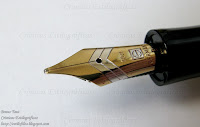The appeal continues—those large nibs were not that common and rarity is always a powerful argument for collectors. On these chronicles we have seen some outstanding examples of large nibs. A couple of impressive size 10 by Waterman, property of nibmeister Yamada, set indeed a very high standard.
How did Japanese companies deal with this need to show affluence? Maki-e decoration was one of the arguments, and it worked well even outside Japan, as the success of the Dunhill-Namiki joint venture shows. Some of those nibs sported some really big nibs —size 50— that are now revived on modern Namiki pens.
But those were not the only examples of big nibs. Earlier in time, in the 1920s, Pilot created nibs as big as size 8 and implemented them in combination of the very unique hoshiawase system to prevent ink leaks from their eyedropper pens. This particular combination is very rare to find, and is priced accordingly.
 A well preserved BCHR pen, albeit there is some oxidation on the cap.
A well preserved BCHR pen, albeit there is some oxidation on the cap.This is a large pen made of hard rubber, and is decorated with a subtle and attractive pattern (BCHR):
Length closed: 148 mm.
Length open: 141 mm.
Length posted: 190 mm.
Diameter: 13.5 mm.
My thanks to Ms. Jade and Mr. Nikos Syrigonakis.
Push in celluloid, lever filler – Pelikan Royal blue
Bruno Taut
September 2nd, 2012
labels: Pilot, plumín, estilofilia
Bruno Taut
September 2nd, 2012
labels: Pilot, plumín, estilofilia















































